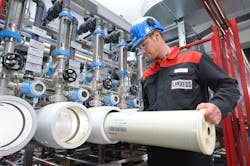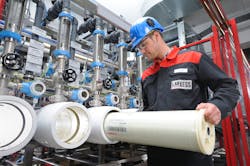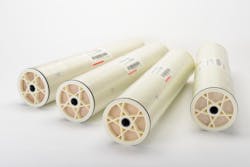Membrane manufacturers have been reliant on commercial polymers developed for a wide variety of applications. Since Dow purchased Filmtec Dow in the 1980s, chemical companies such as BASF and LANXESS have become more engaged in membranes. Able to leverage polymer chemical businesses, will they have clear advantages over traditional membrane companies?
By Dr Graeme K Pearce
Membranes have been used in water treatment for nearly 50 years. Yet mainstream acceptance has only occurred in the last 15 years. Reverse osmosis (RO) has been used to combat water stress, with project development for cities in coastal areas increasing in scale since the mid 1990s. In the case of membrane filtration, ultrafiltration (UF) and microfiltration (MF) membranes were first proposed for large scale water treatment applications in the 1980's and by the end of the 1990's, significant commercialisation occurred.
Initially, users were sceptical that membranes would ever become commonplace because they were too expensive. However, standardization of design in RO led to a commoditisation of the market, encouraging interchangeability between suppliers and sharply declining prices. Eventually, RO challenged thermal processes as the cost of energy rose and the capital cost of membrane plants fell. RO is now considered the standard seawater desalination technology even in the Gulf.
In the case of membrane filtration, the emergence of legislative drivers for cryptosporidium and virus removal in drinking water led to a gradual adoption of the technology. Competition has created downward pressure on prices, but unlike RO the market has retained a significant degree of differentiation.
Membrane manufacturers have developed their products from commodity materials available on the open market. In the case of RO, the market has more or less standardised on the use of the thin film composite polyamide membrane, in which there is a high degree of chemical similarity between the major suppliers with limited opportunity to optimise the basic material. The membrane element is provided in a spiral wound format.
Membrane filtration uses several different materials, but the two most common polymers are polyethersulfone (PES) and polyvinylidene difluoride (PVDF), both produced in high volume for a variety of applications. The use of these materials for membrane manufacture forms a small proportion of the total market for the polymers. They have not been developed specifically for membrane market requirements.
The early membrane makers were faced with difficult decisions regarding the optimisation of their products. Clearly, membranes needed to be highly permeable since this would allow high flux and low operating pressure.
However, they also need to have sufficient strength to maintain integrity and ensure a satisfactory membrane life. Finally, the membranes needed a good low fouling characteristic. These three requirements are to some degree in tension, so commercial products represent a compromise.
Over time, membrane manufacturers have developed a specification for the basic materials in terms of molecular weight etc, and have developed suitable products for water industry application. However, they have been largely reliant on co-polymers and post modification to achieve an appropriate blend of the key characteristics and adjust and control performance of the final product
Current Status of Commercial Membrane Products
As the membrane industry has matured, many membrane makers have now achieved substantial product improvements, sometimes with improvements in all three areas of performance. Some products exhibit exceptional strength potentially sacrificing a degree of permeability. Or conversely, are extremely high permeability at the expense to some degree of resilience. In fact, products supplied for membrane filtration divide fairly equally between these two different combinations of characteristics.
Thus the outside feed format tends to favour the use of a membrane with high strength and flexibility so that a mechanically aggressive air scour can be used in the cleaning cycle. PVDF is often chosen to fulfil this objective. In contrast, the inside feed format has a lower membrane area for a given number of the fibres with the same dimension and so permeability is key; since air scour is not required for this format, flexibility is not a key requirement. Indeed flexible fibres are often found to have lower permeability. PES is the normal choice for this format. However, new materials would offer the potential of a different optimization, perhaps combining strength and permeability more beneficially and with enhanced low fouling properties, thereby enabling the potential trade-off between desirable characteristics to be shifted to a new balance point.
New Membrane IP
There are several recent examples of companies or research groups introducing new membrane IP to improve membrane performance. For example there are some companies that have introduced polymers which are novel or not widely used such as Clean Membranes with its use of a modified PAN membrane, Sumitomo with their modified PTFE, and Water Planet Engineering with their differentiated polymer development.
Also, several companies have promoted co-polymer use, innovative manufacturing methods, or a post modification to the standard polymer families of PVDF, PES, and PS. Examples of some of these developments include Tianjin Motimo in China, Qua of India, and a new start up in Israel, Advanced MemTech. These new introductions have yet to confirm their commercial benefits but all could make a contribution to the trend for improvement. However, there is a limit to the extent to which of any of the developments cited above can influence the fundamental characteristics of their chosen polymer family.
Membrane Performance and Control of Fouling
When membranes were first introduced into water treatment, products were expensive, and there was a strong incentive to operate at as high a flux as possible. Initially, plants can cope with these conditions, but operating costs are high, both in terms of energy and chemical cleaning. However, a more serious impact is that these aggressive conditions may reduce membrane life and result in fibre breakage, especially during feed upsets.
A significant proportion of early plants had an unacceptable track record for integrity loss, fibre failure and repair. Reduction in membrane prices has meant that plants are now designed with lower fluxes, so that fouling rates are significantly lower.
However, it is still the case that at commercially competitive fluxes, fouling is ubiquitous.
Developing membrane properties which minimize fouling and ensure stability to chemical cleaning regimes is therefore essential so that the effects of fouling can be mitigated. Membranes require a high pore density to achieve good permeability, but if too high, strength will eventually be sacrificed.
A narrow pore size distribution is highly desirable since a few large pores will weaken the structure and make the membrane less useful as a barrier for a specific particle size. Also large pores can make the membrane more prone to the pore plugging fouling mechanism.
The pores need to be interconnected to ensure that water can flow through the structure with low resistance. Although these characteristics are to some degree controlled by the method and conditions utilised when the membrane is formed, it is also strongly influenced by the basic nature of the raw material used.
Potential impact of a Material Manufacturer
Material makers have been interested in the membrane water market for many years. An important early example of a strong corporate entrant was when Dow purchased Filmtec Dow in the 1980s.
Dow manufactures several of the polymers used in RO element manufacture, which provided a strong synergy for their business. However, the Dow raw materials utilised have not been specifically modified for use in membrane products.
A more recent entrant to the RO field is Lanxess, a former division of Bayer. They have introduced an RO membrane based on thin film composite polyamide chemistry. It is not clear to what extent Lanxess leverages their related polymer chemical business to provide performance advantage to their RO products. Yet its focus seems to be on the integration of RO with ion exchange, an area in which the former Bayer became strongly established.
There is much more opportunity in UF for a material maker to influence membrane products by adjustment of polymer properties than in RO. As such, it could have a profound effect on the market as BASF brings the potential of material development into the primary source material for membrane making.
Some of the possibilities that BASF might explore include the optimisation of molecular weight of the base PES polymer. This could control morphology and impact on the balance between permeability and strength. It might also be possible to introduce improved flexibility characteristics, making PES potentially more suitable for an outside feed format.
In addition, BASF might consider modification to the PES adding to or adjusting the polymer chemistry to improve hydrophilicity, which could improve fouling characteristics.
Another approach is to develop novel pore formers to control performance characteristics and the potential for pore plugging. Pore formers can be used at relatively high concentration and have a significant impact on the final membrane. Adjusting molecular weight and characteristics of the pore former polymer change could affect the membrane profoundly.
It is likely that the next few years will see polymers developed specifically for the requirements of membranes, especially UF and MF, with basic characteristics which allow improved performance and longevity of the membranes formed. This will provide a general advantage to users and more specifically to the membrane makers that have access to the new polymers that are introduced.
The Potential of Nanotechnology
As a final note, recent developments by Nano H2O have shown that the incorporation of nanoparticles can have a significant effect on RO performance. Research activity in Europe during the 1990s (before the term nanoparticle was coined!) also showed that small inorganic particles could improve UF.
Different materials were studied including titania, zirconia and zeolites. Improved flux and selectivity have been observed, but unlike the Nano H2O development, there were no commercial outcomes. However, material makers could revisit this area and explore membrane improvement through a radically new perspective.
Conclusions and Outlook
Membranes have been used in water treatment for 50 years, and have become widely used for the last 15 years with strong sustained growth for both RO and UF/MF
• The RO market has become largely commoditised with widespread use of the polyamide thin film composite; membranes from different manufacturers are chemically similar
• In contrast the UF/MF market is differentiated with two dominant polymer families, PES and PVDF, available in different formats and feed configurations
• Up to now membrane makers have been reliant on commercial polymers developed for a wide variety of applications; control of the performance of the final product has been achieved by careful selection of the raw polymer material and though the use of polymeric additives, and by some extent by post modification
• Chemical manufacturers have now begun to show an interest in owning membrane makers, and the acquisition of inge by BASF represents the first example of this type of link up in UF.
Dr Graeme K Pearceis principal of Membrane Consultancy Associates. For more information, visit: www.membraneconsultancy.com






